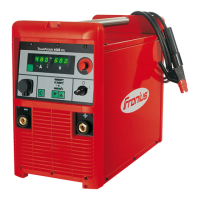Applies to characteristics (5) and (6): Depending upon the welding voltage (arc
length), the welding current (I) will also become either smaller or larger, even
though the value set for I
H
remains the same.
8(V)
60
50
40
30
20
10
0
0
50
100 150
200
250
300
350 400
450
,(A)
I
H
- 50 %
I
H
+
Dynamik
(1)
(8)
(7)
(6)
(4)
(3)
(2)
(9)
(10)
(11)
(5)
Settings example: I
H
= 250 A, arc-force dynamic = 50
(1) Load line for rod electrode
(2) Load line for rod electrode where arc length is increased
(3) Load line for rod electrode where arc length is reduced
(4) Characteristic where "con" parameter is selected (constant welding cur-
rent)
(5) Characteristic where "0.1 - 20" parameter is selected (drooping characte-
ristic with adjustable slope)
(6) Characteristic where "P" parameter is selected (constant welding power)
(7) Example of pre-set arc force dynamic where characteristic (5) or (6) is
selected
(8) Possible change in the current where characteristic (5) or (6) is selected,
as a function of the welding voltage (arc length)
(9) Operating point where arc length is long
(10) Operating point where welding current (I
H
) is set
(11) Operating point where arc length is short
The welding current (I) in the range (9) can be max. 50% lower than the set wel-
ding current (I
H
). Above a certain level, the welding current (I) is limited by the
set arc-force dynamic.
Anti-stick func-
tion
The anti-stick function can be activated and deactivated in "Setup menu: level 2"
(see the section headed: "Setup menu: level 2").
As the arc becomes shorter, the welding voltage may drop so far that the rod
electrode will tend to stick. This may also cause the rod electrode to burn out.
Electrode burn-out is prevented by activating the anti-stick function. If the rod
electrode begins to stick, the power source immediately switches the welding
current off. After the rod electrode has been detached from the workpiece, the
welding process can be continued without any problems.
92
